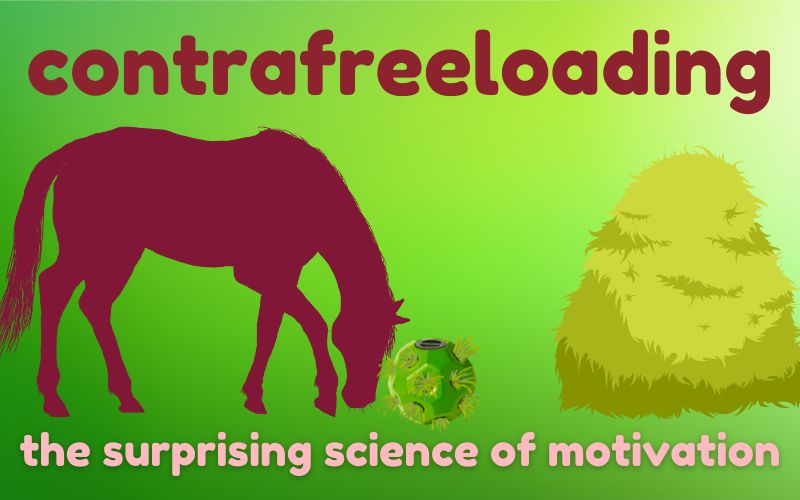
Contrafreeloading: it’s a mouthful! But this cool concept is worth learning about, because it can have a big impact on the way you use enrichment and training with your horse. Read on to find out what contrafreeloading in horses is, how it works, and why it’s important.
What is contrafreeloading?
Contrafreeloading describes the way animals prefer to get food by putting in effort more than getting food for free.
In other words, “freeloading” is receiving food for no work whatsoever. So contrafreeloading means choosing to do work in exchange for food – even when that same food is available for free, no effort involved.
And it turns out, contrafreeloading is what most animals prefer.
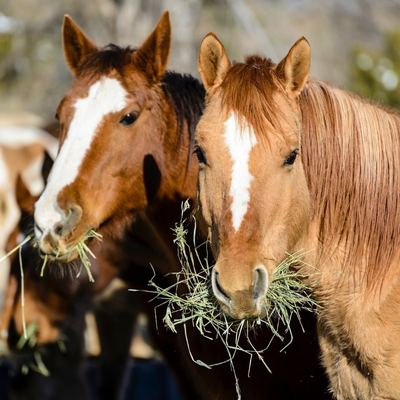
Sounds wild, right? Do animals really prefer putting in effort when they could just eat for free?
Let’s dive deeper and find out more.
Is contrafreeloading in horses real?
Your first response might be to think, No way my horse would rather work for food than just eat it out of a bucket. They LOVE food too much!
Or maybe, my horse is way too lazy. They’d totally rather eat for free.
Both of these takes seem intuitive. After all, as a human, having all your food provided for no effort or cost sounds pretty heavenly. It makes sense that animals would want to take advantage of freely available food.
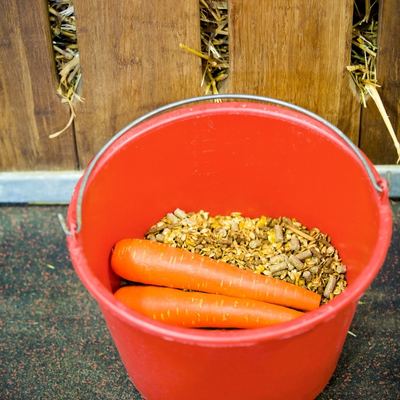
But surprisingly, animals think differently. Contrafreeloading has been observed in many species of animals, and contrafreeloading in horses can show up in several situations.
Understanding the behavior and psychology of contrafreeloading can set you up for more success in both horse enrichment and reward-based horse training.
Now let’s look at the psychology behind contrafreeloading to figure out where it comes from, and how it affects your horse.
The Brain and Contrafreeloading in Horses
Contrafreeloading is an effect of nature’s reward system. It’s older than domestication, originating when your horse’s ancestors lived in wild environments and foraged for their food. Buckle up, it’s time for (one section of) science!
Animals are hardwired to perform certain natural behaviors. Finding and consuming food is a fundamental, must-have behavior for animals, including horses.

But getting enough to eat can be challenging, frustrating, or physically demanding. To ensure that animals are motivated enough to seek food, their brains evolved a natural reward system. Eating releases the chemical dopamine in the brain, which creates feelings of pleasure.
But it’s not just eating that releases feel-good chemicals like dopamine. The behaviors of seeking and finding food is also rewarding. In other words, it feels good to take action, put in effort, and get a food reward in return.
This means that working for food and then eating it activates the brain’s reward system more than just eating by itself.
Behavior and Contrafreeloading in Horses
You can see contrafreeloading in action if you’ve ever picked a handful of grass and held it out to a horse, only to have them sniff it and go back to grazing. The behavior of grazing is more rewarding than eating freebie grass picked by a person. Behavior matters!
Contrafreeloading also validates the idea that there’s more to life than just food, water, and shelter. Animals want and need to do their natural behaviors. From tigers in the zoo to horses in your stable, every animal needs the chance to use their bodies and minds, and have choice over their environment.
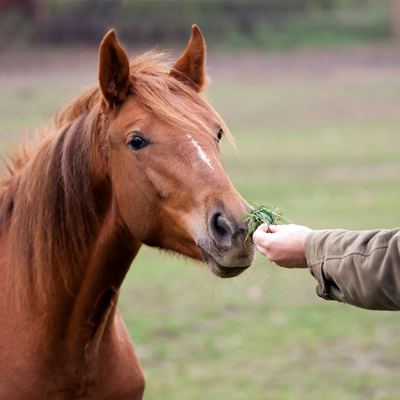
Behavior is so important to animals that it’s considered one of the Five Domains of animal welfare. If you haven’t read this important article on giving your horse the crucial Five Opportunities to Thrive, make that your next stop.
Of course, this doesn’t mean that your horse would prefer plain hay to a bucket full of high-energy, ultra tasty processed feed, or that you shouldn’t ever feed meals from a bucket. It does mean that behavior is important, and even the most food-motivated equine also needs opportunities to eat as nature intended.
So how can contrafreeloading play a role in how you train and care for your horse?
Contrafreeloading and Training
Contrafreeloading has a role to play in reward-based horse training, specifically positive reinforcement.
Positive reinforcement means giving something (food!) when your horse does a behavior you want to see more of. You provide tasty or interesting snacks as an immediate reward for behaviors. Clicker training is the most well-known style of positive reinforcement (the “click” is just a sound used as a signal that a behavior was correct, and a tasty treat is on the way).
For more on positive reinforcement – including what is and isn’t actually R+ – visit this intro article, then come back here. We’ll wait.
So in positive reinforcement training, your horse performs some work or effort, which results in acquiring food. In other words, it sets up the same effort/reward system that motivates animals and encourages behavior. As long as the task isn’t too difficult or uncomfortable, positive reinforcement results in big motivation to participate and learn.

Contrafreeloading is part of why it’s appropriate to use food rewards around horses. Treats won’t make your horse pushy or aggressive – that’s a common myth! Instead, R+ training can allow your horse to enjoy the process of seeking a reward, while you train using less force or punishment.
You can see contrafreeloading in action when you offer a positive reinforcement training session to a horse on pasture or with access to hay. As long as you and your horse are both familiar with training, they’ll likely leave the free food in order to train for the treats in your pouch. No force or pressure necessary. No wonder positive reinforcement often looks like sparkly magic – but it’s not magic, it’s just behavior.
You can even take advantage of contrafreeloading to train your horse to ride out on grass and willingly keep their head up instead of diving to graze!
Contrafreeloading and Enrichment
Contrafreeloading is easy to see when you provide your horse with enrichment items and activities.
Enrichment for horses means encouraging natural behaviors. In other words, it’s giving your horse the chance to behave like a horse, and enjoy variety and stimulation.
Enrichment often involves food and the opportunity to enjoy natural feeding behaviors, use problem solving skills, or fine motor control to get tasty snacks.
In this photo, you can see contrafreeloading in action:
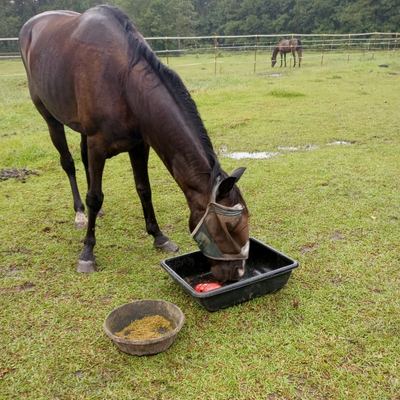
The horse is choosing to work on a challenging slow feeder toy that releases just a few pellets of feed each time the horse pushes it around.
There’s a pile of free food and a pasture full of grass freely available. But the horse has chosen the option that requires more time, effort, and skill. That’s contrafreeloading!
The concept of contrafreeloading is one of the best reasons why horses need enrichment and enriched lives rather than having everything provided at convenience. Horses are adapted for so many amazing behaviors, and thrive on the chance to use their bodies and minds as nature intended.
So the next time you wonder whether expecting your horse to work at a puzzle or feeder is mean, don’t sweat it. Horses don’t just need natural behaviors and challenge. They prefer it!
Related Topics
Positive Reinforcement Training for Horses: 7 Myths
My Horse is Scared of Toys! Why and What to Do
Are Toys Frustrating for Horses?
5 Reasons Your Horse Ignores Toys and Enrichment
References
Free food or earned food? A review and fuzzy model of contrafreeloading.
Great thoughts. But being an owner we care about our equine friends. I try to provide my horses with an enriched natural environment. But don’t you think we can train our horses to like a convenient environment instead of struggling?
Pingback: Are Your Horse Toys and Puzzles Too Hard? Choosing the Right Challenge - Enriching Equines
Pingback: DIY Cardboard Horse Toy: Cardboard Roller Treat Puzzle - Enriching Equines